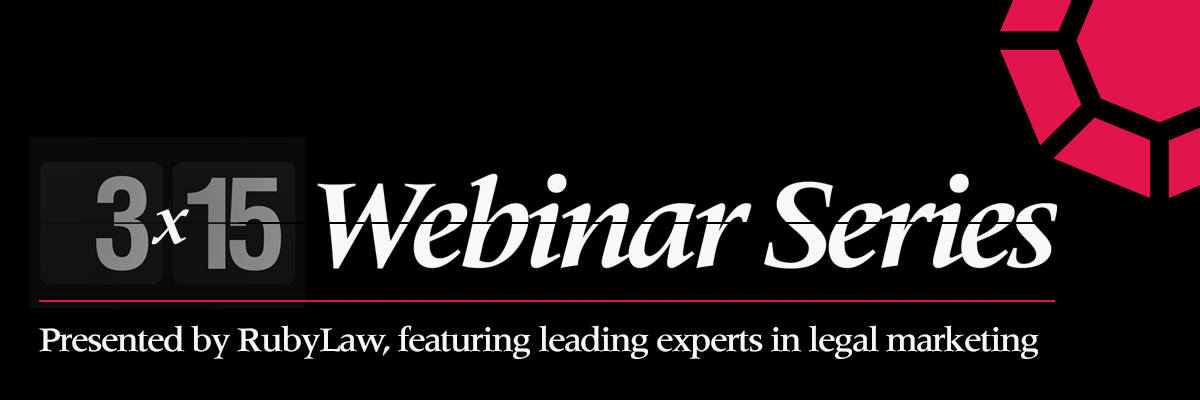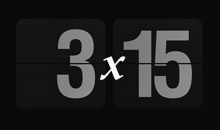Session 3: Launching the 2020 Legal Marketing Technology Stack
How would you evaluate your firm’s response to the COVID-19 crisis? What impact has it had on your website’s traffic and resulting visitor engagement? Could you be better prepared the next time a crisis hits, and what role will your current tech stack play?
It may yet be early to answer some of these questions, but we’ve already started to explore some of the responses.
—If you missed Session #1, Managing legal web properties during a crisis, you can view it here
Transcription
Alexander Kotler (00:07): Greetings, and thank you for tuning into the third, and final, session of the Ruby Law 3X15 Webinars Series launching the 2020 Legal Marketing Technology Stack. Ruby Laws 3X15 Webinar Series is a three part quick bite virtual program, featuring expert practitioners and key members of the Ruby Law team. Each rapid fire session is approximately 15 minutes long and is available for viewing afterward if you can't participate in the entirety of the session, or if you'd like to share it with your colleagues afterward.
Alexander Kotler (00:46): Today's program focuses on the Legal Marketing Technology Stack and features members of our team, me and Jaron, as we provide a sneak preview of this year's edition of the MarTech Stack blueprint for law firms. In case you're wondering, I'm the one on the right.
Alexander Kotler (01:05): If you missed our prior two sessions, Managing Legal Web Properties During a Crisis, or Assessing the Impact of COVID-19 on Legal Marketing Websites, please check them out via the links on screen.
Alexander Kotler (01:17): Finally, if you'd like to ask any questions, please submit them via the Q&A module in Zoom. We'll respond to as many as we can in our session recap email after the webinar ends.
Alexander Kotler (01:28): Before we find out how this final session stacks up against the previous two, let's set the stage for our conversation by quickly reviewing the highlights and takeaways from our conversations with Molly Porter and Ann Kalodis.
Alexander Kotler (01:46): During Managing Legal Web Properties During a Crisis, we learned how Seyfarth quickly spun up a COVID-19 resource center. Molly imparted upon us the importance of having equal grasps on content and technology. By leveraging a flexible, scalable technology system, Seyfarth published a robust, content-rich, adaptable, and resonant destination for site visitors to learn about how the firm was responding to the situation and what services were on offer. The Seyfarth team acted quickly and effectively, and these efforts are now delivering results.
Alexander Kotler (02:26): Next, we spoke with Ann Kalodis of Kramer Levin on the topic of Assessing the Impact of COVID-19 on Legal Marketing Websites. Ann emphasized that defining metrics from the outset allowed for a more effective analysis, as well as actionable decision making. She talked about maintaining accurate customer segmentation and CRM cleanliness to ensure that messaging reaches the right audience while also reducing email fatigue and subscription list opt-outs.
Alexander Kotler (02:57): Finally, not all need to be aligned with the practice. Topics like coronavirus often span multiple practices. Audiences may be looking for cross-discipline content, so factor this possibility into your content strategy.
Alexander Kotler (03:17): If we think about a typical framework for translating abstract concepts into reality, ideas move from a strategic vision and related objectives to tactical plans. These are the specifics of how outcomes will be achieved and by whom. From there, comes execution when plans are implemented. And then finally the results.
Alexander Kotler (03:41): Whether it's legal marketing or any professional endeavor, technology is usually involved and it's almost always an accelerator. Technology speeds processes up to deliver insights faster, often richer, and more accurately than via manual processes. This notion is not groundbreaking and I don't expect anyone's minds to be blown, but I mention it because teams and firms that consider, deploy, and manage technology effectively, and as part of a firm-wide strategy, can launch and iterate campaigns faster, can respond and pivot with precision, and can be more certain of the decisions they're making than those that aren't. And this represents a competitive advantage, which is precisely why having an intelligent ecosystem of marketing technology paired and properly operated can be the difference between firms that win and firms that were.
Alexander Kotler (04:41): Last year, we released the first visualization of the legal marketing technology ecosystem. We adopted the categories popularized by Scott Brinker, including advertising and promotion, content and experience, social and relationships, sales, data, and management, and we applied them to legal. You can see these colored bands across the screen.
Alexander Kotler (05:01): We examined technology systems used by firms of all sizes. This snapshot on screen is last years. It's very long and please don't worry, you're not supposed to be able to read it. It's just there so you can see it. The idea behind publishing it was that being able to create a blueprint afforded the firms an opportunity to document their current state of their marketing technology stacks, and then be aspirational about the future, adopting new systems to accomplish new objectives, meet certain needs and fill often glaring holes.
Alexander Kotler (05:37): We spoke with experts across legal marketing, people like Patty Azimi, Mobina Panicker, Jason Kennedy, Deborah Farone, Rich Marsolais, and others, to provide an accurate and somewhat agnostic viewpoint. Thank you again to them for their input.
Alexander Kotler (05:52): We emphasize the importance of selecting right size systems and avoiding misfits. Just as no one wants to wear a pair of shoes that are two sizes too big, adopting beefy systems that can't be put to work is wasteful. And I did say beefy. The reverse also applies. Trying to squeeze into a simple solution when you're a complex multinational firm is imprudent, to put it mildly. Instead, we suggested focusing on making smart, efficient decisions that align with firm culture, team capabilities, budget, and relative complexity. We believe these ideas still hold. Although, tech stacks are not meant to be fixed in time, rather they must evolve to continue supporting the ever-changing nature of business and life itself.
Alexander Kotler (06:42): Therefore, our work was not complete in 2019, and we are thrilled to share the 2020 edition of the Ruby Law Legal Marketing Tech Stack Blueprint. Before I pass the mic over to Jaron to walk us through the 2020 version, two quick things.
Alexander Kotler (06:55): First, I'd like to acknowledge those that provided input into this sneak peak version, including Helena Lawrence, Jennifer Larivee, Robert Algieri, and others. These legal marketing and technology experts provided us with feedback on the blueprint to make it as true and representative as possible. That said, it remains fluid and we welcome any additional thoughts from audience members from firms of all sizes.
Alexander Kotler (07:20): Secondly, and perhaps most importantly, if you'd like to download a copy of the 2020 stack, you can visit the link at the top right, bit.ly/2020-stack to download one. Don't fret, this link is going to remain up for the duration of the next series of slides, so you're not going to miss it, but please do note it down.
Alexander Kotler (07:41): Now, let me please pass it over to Jaron, who's going to give us the backstage tour of the 2020 Legal Marketing Tech Stack.
Jaron Rubenstein (07:51): Thank you, Alex. Let's start at the beginning. At a high level, we've expanded the stack quite a bit. This is what it currently looks like in the 2020 version. Let's talk a little bit about what's changed.
Jaron Rubenstein (08:11): We got a lot of wonderful feedback from folks across the sector and beyond, many that were not necessarily cited in the thank yous, but folks that really reacted to having a document like this and what the usefulness of it was for their organizations.
Jaron Rubenstein (08:29): So at a high level, let's examine some of the categories that have changed, starting with sales. We split the category into two systems based on related activities and the information occurring now. So within business development, we now have sales enablement.
Jaron Rubenstein (08:45): Sales enablement system is power processes that give sales organizations, or more apropos of law firms, business development departments, the information, content, and tools to close deals and win clients more effectively.
Jaron Rubenstein (09:00): So while these methodologies have always existed, technology is being used to a greater degree than ever within firms to provide greater insight into pipeline activities and the participants involved in winning new business.
Jaron Rubenstein (09:13): On the other side of the department, are proposal and document generation systems. Tools that formalize and deliver beautiful, highly refined, dynamic, brand aligned and customized materials to prospects and other stakeholders. These tools even go beyond business development teams and give attorneys and their assistants the ability to quickly output ride along documents that don't necessarily need approval from marketing and business development, because they're already up to date, factually correct, and elegantly styled.
Jaron Rubenstein (09:46): Next within content and experience, we have digital client engagement. This system refers to chat bots and live updates, technologies that provide immediate in-session engagement with your site visitors and prospects. It's sometimes powered by machine learning and artificial intelligence. Chat bots, chat flows, conversational marketing, whatever you want to call it, provide a means for qualifying leads, routing visitors to relevant content, and increasing the likelihood that a visitor has a beneficial, if not expeditious, experience on your site.
Jaron Rubenstein (10:23): Similarly, live updates like RubyLaw, notify, alert, visitors to the existence of newly created content that aligns with their interests, and their business goals.
Jaron Rubenstein (10:33): Finally, within data, we have data enrichment. Now with GDPR and other privacy measures in place, this technology can be highly useful, but must be applied with prudence. Data enrichment effectively fills in the gaps and provides information about prospects, where your ability to capture it or their desire to provide it is absent.
Jaron Rubenstein (10:53): Before we move on to a sample stack. I also want to mention that we've updated much of the technology, namely the brands, the systems, excuse me, the software associated with each category and with each size firm. This is as much about keeping this document fresh as it is a reflection of the changing working and living environment that we find ourselves in.
Jaron Rubenstein (11:12): For instance, we're all using tools for virtual meetings, webinars, and collaboration. The social relationships and management categories are evolved to showcase the world of remote work and the crossover that these categories have.
Jaron Rubenstein (11:27): To illustrate how one might use this document, we've provided a sample marketing tech stack for a large law firm. And this is also a reminder that the tech stack is available in multiple sizes for small, medium, and large-sized firms. And so depending on the size of your firm and your marketing and business development departments, you may find one more appropriate for your firm than the others.
Jaron Rubenstein (11:48): In this example, we're showing just some of the sample technologies that a large firm might use. This isn't any particular large firm, but it shows how they might be using, for example, JDSupra, for content syndication, RubyLaw for their website and proposal generation, Vuture, for newsletters and client alerts, ON24 for webinars, et cetera. This is a page of the tech stack that you'll be able to download. You'll be able to explore this a little bit further and give some thought to how that might apply to you, which leads me to the next slide, which is a blank.
Jaron Rubenstein (12:23): This essentially is a blank blueprint for you to create your own. This is another page of the download and will allow you to just get started on understanding what systems and what technologies you have in place at your firm to implement each of these categories and give some thought to what your current scenario looks like and how it's being used.
Jaron Rubenstein (12:45): And speaking of that, you don't have to use our blueprint as your template. You can define whatever makes the most sense. Here are two visualizations from two of our clients, Allen Matkins, and Benesch. Thank you to Stefanie Knapp at Allen Matkins and Julie Gurney at Benesch, and their teams, for allowing us to share these with you today. Stefanie and Julie were panelists at one of the programs we held last year at the LMA Northeast Conference in Brooklyn, and they shared these with the audience at that time. And they've graciously allowed us to share them with you again today.
Jaron Rubenstein (13:20): These are, again, examples of what specific technologies and tools those teams are using to implement their marketing technology stacks at that time last year.
Jaron Rubenstein (13:29): So as we only have a limited amount of time together, we're quickly headed to our own conclusion, which means it's take away time. So here are three.
Jaron Rubenstein (13:36): The first is to consider completing a blueprint of your own MarTech stack based on your firm's current systems. And you can use our blank or you can devise your own. But essentially take inventory of the systems you're currently using.
Jaron Rubenstein (13:51): The second is to think about what you see in the future for your organization, perhaps one to three years into the future, and create an aspirational blueprint, a version that identifies the gaps and the opportunities as well as realistic goals for your team and your organization.
Jaron Rubenstein (14:07): And then finally determine what needs to happen in order to get there. So whether it's normal working operations and normal growth for your team, or just being ensured that you're better prepared the next time that something bananas happens. Be sure that you're planning ahead and that you have a path for how you're going to get there over time.
Jaron Rubenstein (14:28): If you've come to any conclusions, you have ideas or feedback about the technology stack, we do very much hope that you'll reach out and share those with us. You can contact us through all the various means that you're aware of, email and the website, et cetera, but please do let us know if there's things that you might see omitted, things that you might think about differently. This is a living document and a resource that we hope to provide to the team, or to the sector, for the foreseeable future, and so please help us to continue to improve it and make sure it's as robust and comprehensive as possible.
Jaron Rubenstein (15:01): With that, I'm going to pass it back to Alex to take us home.
Alexander Kotler (15:07): Thank you, Jaron. So looking back on the 45 minutes, or the three 15 minute sessions that we've had, we've got three takeaways for you, and we've distilled them right here and now.
Alexander Kotler (15:18): The first one, technology plays a critical role in your firm's ability to respond to crises with effectiveness. Again, I feel like I'm saying things that you already know, but what's critical is not the existence of the technology or which brands or what reputations the systems have, but why each one has been selected.
Alexander Kotler (15:39): Two, integrate your technology into everything. This includes firm culture, processes, and the roles team members play. This will increase the likelihood that your goals are practical and that your execution will yield the desired results. In this case, it's less about the literal integration between systems and more about the adoption and successful implementation of processes and collaboration.
Alexander Kotler (16:04): Three, continue to measure, assess, evolve, and improve. If this were neater, we'd have had a fun acronym that you could remember, but we don't have one. So let's just focus on measuring, assessing, evolving, and improving, and then taking the approach that's going to best support you in being prepared for whatever unknowns lie ahead.
Alexander Kotler (16:29): And with that, I want to thank Jaron Rubenstein for his time and insight. I'd also again like to thank Molly Porter and Ann Kalodis for participating in our previous sessions. Thank you also to this year and last year's contributors to the Legal Marketing Technology Stack, and thank you to our audience.
Alexander Kotler (16:44): We'll be following up by email to provide a link to watch this session, as well as responses to any questions. If you missed any of our previous sessions or simply want to rewatch them, which I highly recommend, please visit the links on screen. You can also download your copy of the 2020 Legal Marketing Tech Stack at bit.ly/2020-stack. Thank you for tuning in to the Ruby Law 3X15 Webinar Series. We'll see you next time.



